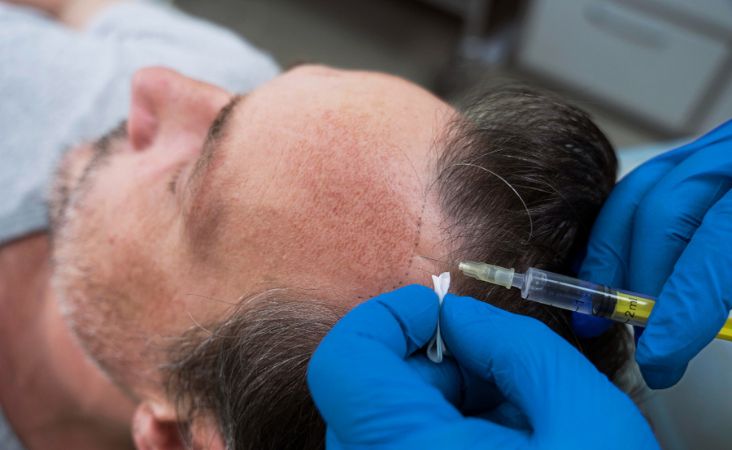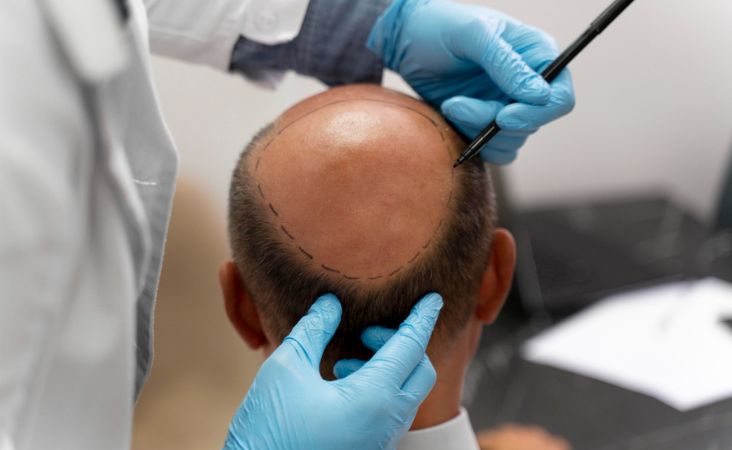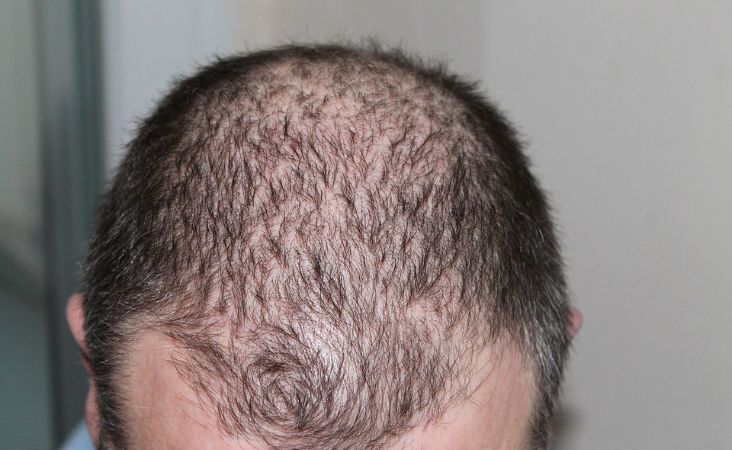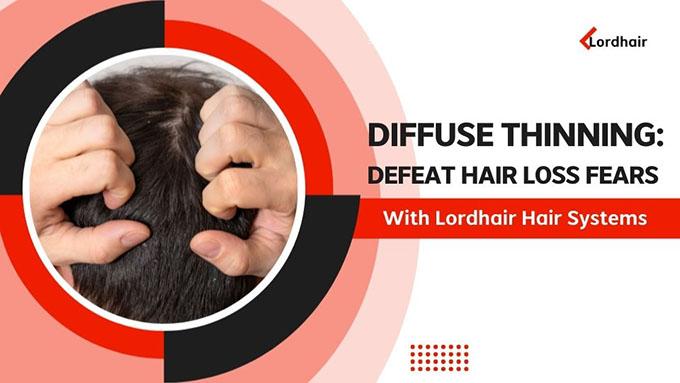How Much Hair Transplant Costs in 2024? Bonus Hair Surgery Insights Included
- Written by Vivek Khullar
- | Published Mar 15, 2024
- |
- 7 min read
 Listen to the full text
Listen to the full textWhen it comes to finding a surgical fix for hair loss, one solution that stands out prominently is hair transplant. It has been a beacon of hope for many battling initial signs of hair loss. However, amidst the excitement of potential restoration, one crucial aspect often remains shrouded in mystery - hair transplantation cost.
Surprisingly, many are unaware of the financial investment required for this transformative procedure. If you’re one of them, keep reading!
In this blog, Lordhair will share all the details related to hair transplant expenses and surgery costs. Join us as we delve into the realm of hair surgery pricing, shedding light on what it takes to undergo the procedure. But before we crunch the numbers, let's take a moment to understand what a hair transplant truly is.
What is a Hair Transplant?
A hair transplant is a surgical procedure that helps fix hair loss by redistributing healthy hair follicles from one part of the body to areas experiencing thinning or baldness. It’s an innovative technique that offers a semi-permanent solution for those seeking to restore a fuller, more youthful head of hair.
The procedure begins with the extraction of donor hair follicles. Wondering from where precisely your hair is pulled? Usually from the back or sides of the scalp since hair in these places is more resistant to balding. These follicles are then meticulously transplanted into recipient sites on the scalp. They are strategically placed to achieve natural-looking results.
According to dermatologists, hair transplants rely on the principle of donor dominance wherein transplanted hair retains the characteristics of its original location (such as texture, color, and growth pattern). This guarantees that the newly transplanted hair seamlessly blends with existing hair. Fundamentally, creating a cohesive and harmonious appearance.
Over time, the transplanted follicles establish a blood supply and begin to grow. They gradually fill in areas of thinning or baldness. While results may vary depending on individual factors such as hair quality and the extent of hair loss, many patients experience significant improvement in hair density and overall appearance.

What are Different Types of Hair Transplant?
We believe that understanding the cost of a hair transplant becomes significantly more meaningful when one has an idea about the nuances of the various types available. Why, you ask? Because each type offers unique benefits and considerations that can influence both the procedure's outcome and its associated expenses.
So, let’s explore the different types of hair transplant procedures, providing you with insights to make informed decisions about your hair restoration journey.
#1 Follicular unit transplantation (FUT)
FUT involves harvesting a strip of scalp from the donor area and dissecting it into individual follicular units under a microscope. These units contain one to four hairs each. They are then transplanted into recipient sites on the scalp. FUT is known for its efficiency in transplanting a large number of grafts in a single session which makes it suitable for extensive hair loss cases.
However, it may leave a linear scar at the donor site which can be a concern for some patients. This procedure is slightly dated and cheaper than the next option we will be discussing.
#2 Follicular unit extraction (FUE)
Next up, we have FUE. Now just unlike the previously mentioned hair transplant surgery, it involves extracting individual follicular units directly from the donor area using a small punch tool. Meaning, there’s no need for a linear incision. This minimally invasive technique leaves tiny, round scars that are less noticeable than those from FUT.
Follicular Unit Extraction surgery is favoured for its ability to harvest grafts from various parts of the body (chest, beard, etc.). It provides flexibility in donor site selection. Additionally, it offers faster recovery times and less post-procedure discomfort compared to FUT.
Check out our other hair recovery resources as well:
Hair plugs vs. hair transplant
Hair transplant complications to consider in 2024
Everything about sudden hair loss and thinning in men
Elon Musk’s hair transplant story
#3 Direct hair implantation (DHI)
A specialized form of FUE, DHI utilises a Choi implanter pen to directly implant harvested grafts into the recipient sites. This eliminates the need for creating incisions beforehand. Result? More precise and efficient transplantation process with minimal handling of grafts!
Direct Hair Implantation (DHI) reduces the risk of damage and improves survival rates. It offers natural-looking results with high hair density. DHI is also suitable for patients seeking a minimally invasive approach with faster healing times.
#4 Robotic hair transplantation
As the name suggests, robotic hair transplantation involves using an automated system (such as the ARTAS robot) that assists in extracting and transplanting hair follicles. The robot utilizes advanced imaging and artificial intelligence algorithms to identify and harvest individual follicular units with precision.
This technology not only allows for greater accuracy but also consistency in graft extraction. It potentially reduces the risk of human error. Robotic hair transplantation offers patients the benefits of minimally invasive surgery, precise graft placement, and faster recovery times. About the cost of this hair transplant surgery, well, it's bound to be costlier than all the others.
#5 Stem Cell Hair Transplantation
Last on our list is stem cell hair transplantation surgery! It harnesses the regenerative potential of stem cells to stimulate hair growth and enhance the results of traditional hair transplant procedures. This innovative approach involves isolating stem cells from the patient's own adipose tissue or bone marrow and injecting them into the scalp along with transplanted hair follicles.
Stem cells have the ability to promote tissue regeneration and improve blood circulation. These may accelerate the healing process and enhance hair growth. We haven’t discussed the cost of this hair transplant surgery yet but one thing is for certain - it holds promise for improving the long-term outcomes of hair restoration procedures and addressing advanced cases of hair loss!

What’s the Cost of Hair Transplantation in 2024?
Although pinpointing the exact cost of hair transplant surgery proves challenging due to varying prices across countries and surgical centers, we can provide you with a ballpark figure! Hair transplant procedures typically range from US$15,000 to US$25,000. Check out the video below for Canadian pricing insights. Keep in mind that this cost can exceed further depending on the chosen doctor and additional sessions required.
Multiple sessions are usually necessary for optimal results. This too can potentially increase the overall expense. Yes, we mean more than US$25,000. Despite the significant investment, hair transplants sometimes don’t offer long lasting results.
The renowned Canadian hairstylist Aaron O'Brayan recently shared his experience with multiple hair transplants. While he found some improvement, it wasn't quite the transformation he desired.
Consequently, Aaron opted for an alternative solution, highlighting the importance of exploring various options to achieve desired outcomes. Wondering what that option could be? Well, don’t worry, we won’t leave you on a cliffhanger!
Here, watch this video to find the answer:
Is Hair Transplant Actually Safe?
Now that you've got a glimpse of the potential cost involved in a hair transplant, some of you may be wondering, “But is hair surgery safe? Are there risks or side effects I should be aware of?” Sadly, YES! Just like any surgical intervention, hair recovery surgeries that we talked about above do carry certain risks.
Here are some potential side effects to be mindful of:
#1 Infection at surgical site
Infection is a rare but is a possible complication following hair transplant surgery. It can occur if bacteria enter the surgical site during or after the procedure. Symptoms of infection may include redness, swelling, warmth, and pus at the transplant site.
Infections are typically treated with antibiotics prescribed by a healthcare provider. Proper wound care and adherence to post-operative instructions can significantly reduce the risk of infection.
#2 Bleeding
Some bleeding is normal during and immediately after a hair transplant procedure. However, excessive bleeding can occur if blood vessels are damaged during the surgery. Your surgeon might apply pressure to the affected area to control bleeding during the procedure.
You also have to avoid activities that may increase bleeding post-operatively. In rare cases, additional medical intervention may be required to address persistent bleeding.
#3 Scarring
A potential side effect of hair transplant surgery, particularly with Follicular Unit Transplantation (FUT) since it involves removal of a strip of scalp from the donor area! This method can leave a linear scar along the donor site which may be noticeable, especially with short haircuts. Scar appearance can vary depending on individual healing and the skill of the surgeon.

#4 Temporary numbness or lack of sensation
A side effect that you might witness even after paying the high cost of hair transplant surgery. Temporary numbness or lack of sensation in the donor or recipient areas is common following this hair recovery procedure. This numbness typically resolves within a few weeks to months as nerves regenerate.
Patients may also experience itching or tingling sensations during the healing process.
#5 Folliculitis
For those who don’t know, folliculitis means inflammation of hair follicles. It is a potential complication following hair transplant surgery. It may manifest as small, red bumps or pustules around the transplanted hair follicles. Folliculitis can be caused by bacterial or fungal infections, irritation, or ingrown hairs.
Treatment may involve topical or oral antibiotics to reduce inflammation and prevent infection. Proper hygiene and post-operative care can also help prevent folliculitis.
#6 Itching or swelling at transplant site
Itching and swelling are other known side effects that men and women might face after paying the complete hair transplant surgery cost. These symptoms may be more pronounced in the recipient area where new hair follicles have been transplanted. Itching or swelling typically resolves within a few days to weeks.
Patients are advised to avoid scratching the transplant site to prevent damage to the newly transplanted follicles.
#7 Shock loss
Shock loss (also called temporary shedding of transplanted hair) is another known side effect of undergoing transplant surgery. It occurs when transplanted strands enter a dormant phase and shed before regrowing. Shock loss typically occurs within the first few weeks to months following surgery and may be more noticeable in some patients than others.
While it can be concerning, new hair growth usually begins within a few months. Yes, you read it right! Transplanted hair eventually regrows.
Read More: Forehead Reduction Surgery
What is the Safer Alternative to Hair Transplant Surgery?
If you're seeking a safe and risk free alternative to hair transplant surgery, look no further than a hair system. Aaron O'Bryan is a testament to its effectiveness as he confidently wears one himself. But what exactly is a hair system? Well, it's a hand-made hair recovery solution crafted from high-quality materials such as human hair attached to a breathable, skin-like base.
What sets a hair system - also known as toupee, men’s human hair wig, hairpiece, and topper - apart as a safe alternative is its non-surgical nature. Unlike hair transplant surgery which involves invasive procedures and potential risks, using a hair system requires no surgical intervention whatsoever. Instead, the system is meticulously crafted to match your natural hair color, texture, and style preferences. It seamlessly blends with your existing hair for a flawless appearance.
Moreover, opting for a hair system eliminates the need for extensive recovery periods and associated downtime. This makes it an attractive option for those seeking immediate results without the hassle of surgery. With advancements in technology and materials, modern hair systems offer unparalleled realism, durability, and comfort. They allow wearers to enjoy a natural-looking head of hair with confidence.
So, whether you're looking to improve your appearance or regain lost confidence, a well-crafted hair system will offer a reliable path to achieving your desired look. It will deliver you safe and quick results.
Check out how amazing Chris looks after buying a Lordhair’s non-surgical replacement:
Hair Transplant Cost: Final Words
Above, we've provided comprehensive insights into the world of hair transplant surgery including its costs, risks, and a popular non-surgical alternative. Now you're equipped to make informed decisions about your hair restoration journey. If you're thinking of buying non-surgical hair replacement, look no further Lordhair!
Our meticulously crafted systems offer unmatched comfort, durability, and natural-looking results. Lightweight and breathable, they seamlessly blend with your existing hair, providing a hassle-free solution to hair loss concerns. And perhaps most importantly, they offer an affordable alternative to hair transplant surgery. Meaning, you can achieve your desired look without breaking the bank!
Explore our range of men’s hairpieces and women’s wigs today and take the first step towards restoring your confidence and reclaiming your youthful appearance. Contact us in case of queries.



